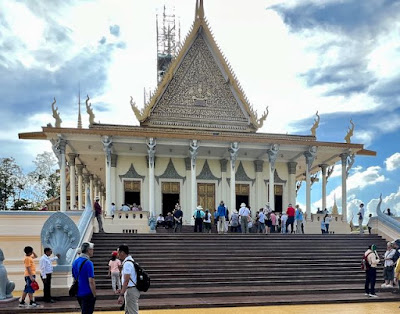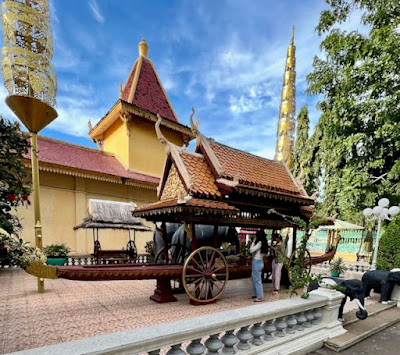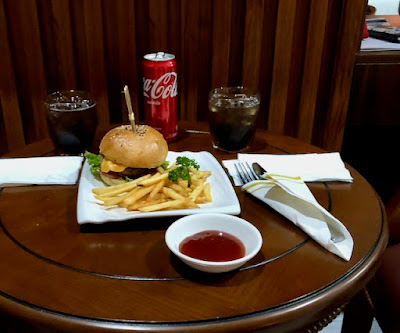Phnom Penh is the capital and most populous city in Cambodia.
The city of Phnom Penh succeeded Angkor Thom as the capital of the Khmer nation but was abandoned several times before being re-established in 1865 by King Norodom.
Located on the banks of the Tonlé Sap, Mekong, and Bassac Rivers, Phnom Penh is home to more than 2 million people, approximately 14% of the Cambodian population.
Phnom Penh has a tropical wet and dry climate. The climate is hot year-round with only minor variations. Temperatures typically range from 72° to 95° F and weather is subject to tropical monsoons. The southwest monsoon blows inland from May to November. The northeast monsoon ushers in the dry season, which lasts from December to April. The city experiences the heaviest precipitation from September to October with the driest period in January and February.
DAY 1
On October 26, 2023, I reached Phnom Penh Cambodia, following an uneventful six-hour bus ride from Siem Reap Cambodia.
The sight of my private guide awaiting my arrival at the Phnom Penh bus station was a pleasant surprise.
Once my luggage was in good hands, we set off for a captivating tour of the Royal Palace.
The day continued to unfold beautifully as I hopped on a private boat for a delightful one-hour Mekong River cruise following my palace exploration.
The Mekong River water, reminiscent of the Mississippi River, is quite muddy, with abundant floating Pontederia Crassipes, also known as Water Hyacinth.
We docked just as the sun set on the Mekong, but the short 1.8-mile drive to The Onra Hotel turned into a 35-minute journey due to heavy traffic.
Check-in at 6:30pm led me to room #406, and unfortunately, the room design left much to be desired. From the hefty two-ton door to a tub that practically needed mountaineering skills. Then there was the shower wand with an inclination for skin-blasting drama, not to mention the dimly lit coffee maker and mirror areas which seemed to add a touch of mystery. Finally, it was the stubborn air conditioning that defied any settings and turned my bed into an icebox.
After a day filled with numerous experiences, the idea of venturing out for dinner did not entice me and I felt I could deal with the room flaws. Fortunately, prompt room service came to the rescue.
The menu prices in Phnom Penh were noticeably higher than what I'd encountered in Siem Reap. A satisfying meal, a refreshing shower, and the allure of the bed made it impossible to resist.
DAY 2
At 5:30 am, I woke up, momentarily disoriented with my surroundings. The metal plate on the in-room phone quickly reminded me that I was at The Onra Hotel in Phnom Penh.
A complimentary buffet breakfast awaited on the 13th floor after 6am. I found myself at breakfast this morning at 7:10am.
My private guide, scheduled to meet me in the hotel lobby at 8:00 am, was once again right on time. The day’s itinerary included the haunting visit to the Killing Fields of Choeung Ek and the Tuol Sleng PrisonMuseum, also known as "S-21".
Situated about 10 miles south of Phnom Penh, Choeung Ek, a former orchard, became the site of mass graves for victims of the Khmer Rouge between 1975 and 1979.
The fall of the Khmer Rouge regime after 3 years, 8 months and 21 days, revealed mass graves with 8,895 bodies. Today, Choeung Ek stands as a memorial marked by a Buddhist stupa, housing over 5,000 human skulls as a chilling testimony to the atrocities. The sheer scale of the tragedy, with up to 1.7 million Cambodians losing their lives during this time, is both staggering and deeply moving.
Next stop was back in town at the Tuol Sleng Genocide Museum. Today, the former Tuol Sleng High School stands as the Tuol Sleng Genocide Museum, housing chilling displays of Khmer Rouge torture devices and haunting photographs of their victims. The museum serves as a stark reminder of the atrocities committed during that dark period.
Tuol Sleng High School fell under the control of Pol Pot's forces and was transformed into the “S-21” prison camp where individuals were detained and subjected to torture. Pol Pot's vision for a return to an agrarian economy led to the targeting and execution of many perceived as educated, "lazy," spies, or political enemies. The grim consequences included starvation due to the failure of the agrarian society and the exchange of Cambodia's rice for bullets and weaponry from China. An estimated 20,000 people were imprisoned at Tuol Sleng and it was one of 196 torture and execution centers established by the Khmer Rouge.
When prisoners were first brought to Tuol Sleng, they were made aware of ten rules that they were to follow during their incarceration. What follows is what is posted today at the Tuol Sleng Museum. The imperfect grammar is a result of faulty translation from the original Khmer:
- You must answer accordingly to my question. Don't turn them away.
- Don't try to hide the facts by making pretexts this and that, you are strictly prohibited to contest me.
- Don't be a fool for you are a chap who dare to thwart the revolution.
- You must immediately answer my questions without wasting time to reflect.
- Don't tell me either about your immoralities or the essence of the revolution.
- While getting lashes or electrification you must not cry at all.
- Do nothing, sit still and wait for my orders. If there is no order, keep quiet. When I ask you to do something, you must do it right away without protesting.
- Don't make pretext about Kampuchea Krom in order to hide your secret or traitor.
- If you don't follow all the above rules, you shall get many lashes of electric wire.
- If you disobey any point of my regulations you shall get either ten lashes or five shocks of electric discharge.
The structures were surrounded by electrified barbed wire, with classrooms transformed into cramped prison and torture chambers. Iron bars and barbed wire covered all windows, designed to prevent both escapes and suicides. During the Khmer Rouge control, an estimated 20,000 individuals (though the actual number remains unknown) were imprisoned at Tuol Sleng. At any given time, the prison accommodated between 1,000 and 1,500 prisoners who endured relentless torture. The victims were tortured and coerced into naming innocent family members and associates, leading to further arrests, torture, and ultimately, death. The depth of cruelty during that period is truly chilling.
 |
| Memorial |
 |
| Kitchen |
Out of an estimated 20,000 people imprisoned at Tuol Sleng, there were only twelve known survivors: seven adults and five children. One child died shortly after the liberation. As of mid-September 2011, only three of the adults and four children are thought to still be alive.
 |
| 7 survivors of "S-21" |
During my visit, I encountered Bou Meng and Vann Nath in the courtyard of Tuol Sleng “S-21”. These two survivors, who managed to endure the horrors of the prison through their useful skills, were engaged in conversations with visitors. It was a powerful and poignant experience to interact with individuals who lived through such a dark chapter of history.
 |
| Survivor of S-21: Bou Meng |
 |
| Survivor of S-21: Vann Nath |
Following a emotionally draining morning, I was dropped back at the hotel, allowing me to rest and reflect on the day’s experiences.
DAY 2
Today started early as I had to catch an 8 am bus from Phnom Penh, Cambodia, to Ho Chi Minh, Vietnam. Waking up at 5:30 am, I was ready for breakfast by 6 am. A driver with a mini-van arrived at 7:15 am to collect Marci and I. We then made three other hotel stops to pick up passengers. We reached the bus station by 7:50 am, where I presented my ticket confirmation and was directed to another awaiting larger bus.
Marci and I were again assigned seats 2A and 2B and, just like before, we received a small pastry, a bottle of water, and a moist towelette.
The journey, including the border crossing from Cambodia to Vietnam, kicked off exactly at 8am, marking the start of a 7-hour ride to Ho Chi Minh, Vietnam.











































No comments:
Post a Comment